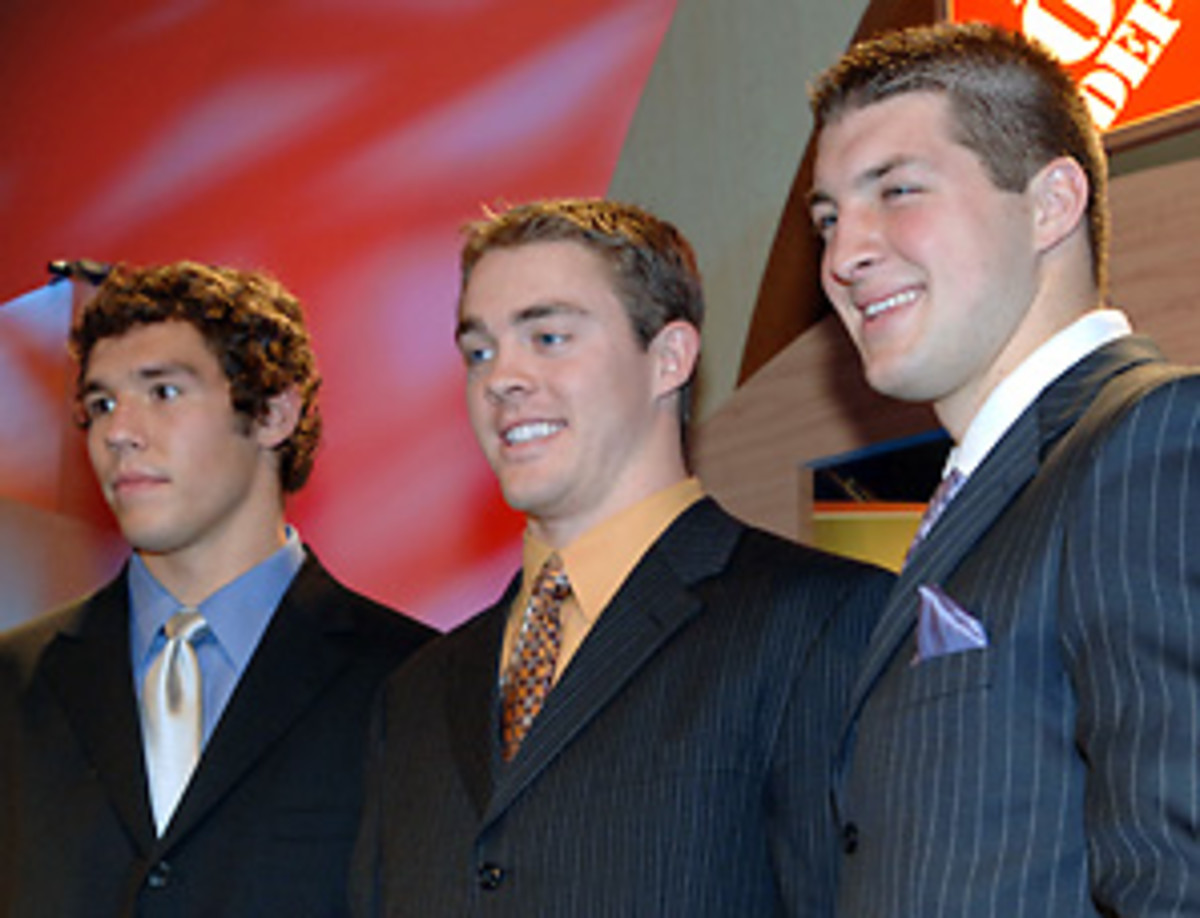
Here's where the Bradford, McCoy, Tebow trio ranks in Heisman lore
For months, the Heisman hype machine has churned. Athletic departments have debated how best to sell their school's hope for landing the stiff-arm statue. Posters? DVDs? Neck ties? Retro ViewMasters? Maybe a mammoth poster in Times Square? Whatever direction they go, the excitement sets in long before fans take their seats for season openers in sun-drenched stadiums, from Eugene to Tallahassee, Chestnut Hill to Pasadena.
As the season openers approach, campaigns at Cal, Clemson and Tennessee are already in full swing. The Golden Bears launched Simply The Best to promote running back Jahvid Best; the Volunteers set up Berry4Heisman to make the case for safety Eric Berry; the Tigers are distributing growth posters to celebrate running back C.J. Spiller.
It's all par for the course in college football's answer to the Oscar push, where manufacturing hype is the name of the game. But this time, with Sam Bradford (Oklahoma), Colt McCoy (Texas) and Tim Tebow (Florida) returning, the hype will be real.
For the first time since the Downtown Athletic Club began handing out the award in 1935, the top three vote-getters from the prior season, two of them (Bradford and Tebow) former winners, are back. With history on their side, they've dominated the preseason Heisman discussion and are considered by most sure-fire bets to make it back to New York. Sports book Betus.com, for example, lists Tebow at +200 to win and Bradford and McCoy at +227. The next best bet: Ohio State's Terrelle Pryor at +800.
But to put it all into perspective, it helps to know how the trio fits into the annals of Heisman history; how, specifically, this group stacks up against the 10 other classes whose winner returned the following year. Of course, therein lies the problem. As stated, this is the first time two winners have returned. Right off the bat, we have to level the field. On top of that, offensive evolution has made it nearly impossible to compare stats from different eras. (Consider: Winner Davey O'Brien passed for 1,733 yards and 19 touchdowns over the 11-game 1938 season, while Bradford threw for 4,720 yards and 50 scores over 14 games in 2008.)
So to find how this class ranks among the others, we'll be using a two-part formula stemming from voting data and the players themselves, not on-field production.
Here's the breakdown:
• Part I: V (votes). Each player who received at least 10 percent of the first place votes earns 10 points.
• Part II: C (classes). Points are assigned based on a player's year (four points for a freshman, three for a sophomore, two for a junior and one for a senior) and the scores are combined for the players in a given class.
Here's where that leaves us:
Using the V+C formula, the 2008 trio of golden-armed quarterbacks earns 37 points, which places it at the top alongside the 2004 threesome of Matt Leinart (the winner), Adrian Peterson and Jason White.
So do we truly have one of the most storied returning classes in Heisman history? Three of the other classes (1945, 1950, 1974) all included three College Football Hall of Famers, and that '74 class included Archie Griffin, the only two-time winner in history. The '04 class included two winners in Leinart and White plus Peterson, whose runner-up finish was the highest ever for a freshman. But the '45 group may be the most storied of all, with Army's Mr. Inside, Doc Blanchard and Mr. Outside, Glenn Davis, America's heroes and TIME magazine cover boys, finishing 1-2.
Tebow's popularity may rival that of Army's Touchdown Twins. He, Bradford and McCoy may all be enshrined in South Bend one day. But do they really rank among the giants of the sport?
If we're basing this strictly on the votes, then yes. If we're being a little more savvy about it, maybe not. Not to downplay this group's accomplishments, but it did benefit from a change in voter attitude. In the first 66 years of the award, freshman and sophomores finished in the top three just nine times. Since 2001, they've done so seven times, with sophomores winning each of the past two years. Prior to 2003, the winner had returned just seven times. In the past five years, the winner had returned three times. (Bradford's return will be the 11th overall).
Bradford, McCoy and Tebow also represent what the award has become. Long ago, staying in the national title race wasn't a prerequisite (see Paul Hornung, the 1956 winner who quarterbacked a 2-8 Notre Dame team) and mid-major players actually stood a chance. These days, no player from outside a BCS school has finished higher than third in voting since San Diego State's Marshall Faulk finished second to Gino Torreta in 1992. It's no coincidence Bradford, McCoy and Tebow were not only the most visible players at marquee schools, but played for teams that spent much of the season in the BCS title hunt, and therefore in the consciousness of voters.
A perfect storm put Bradford, McCoy and Tebow in New York a year ago and brought all three back this season. Their return promises a Heisman race unlike anything we've seen. As for how history views their return, well have to wait until Dec. 12 when the award's 74th recipient is announced. It's hard to imagine anyone outside the quarterback trio winning, and if McCoy takes home the hardware, bowl season will see three active winners take the field.
With that possibility in store, this chase won't need help from Madison Avenue or mass mailings. This time, the hype will be real, and it will generate itself.





